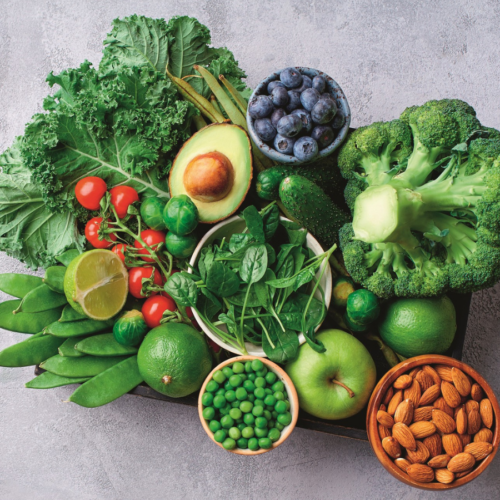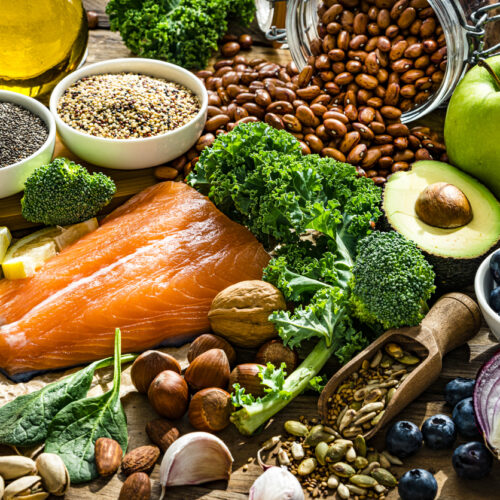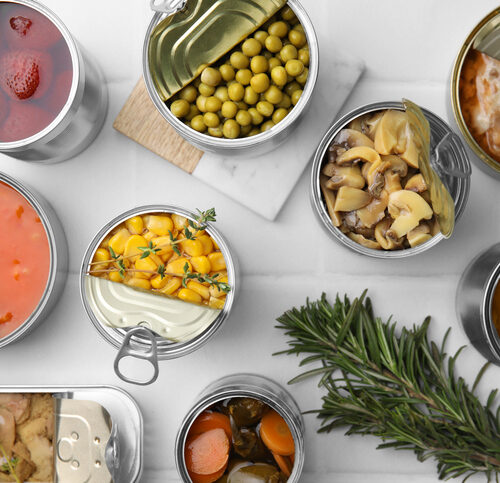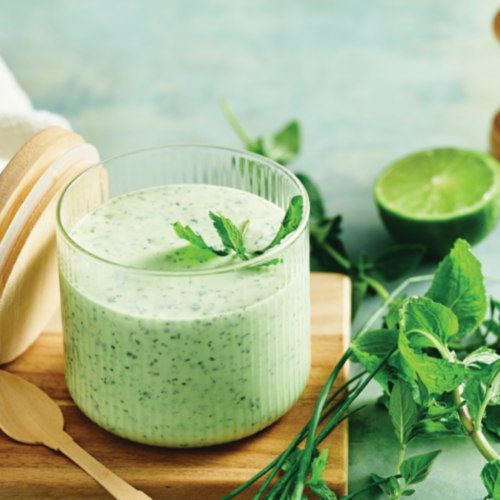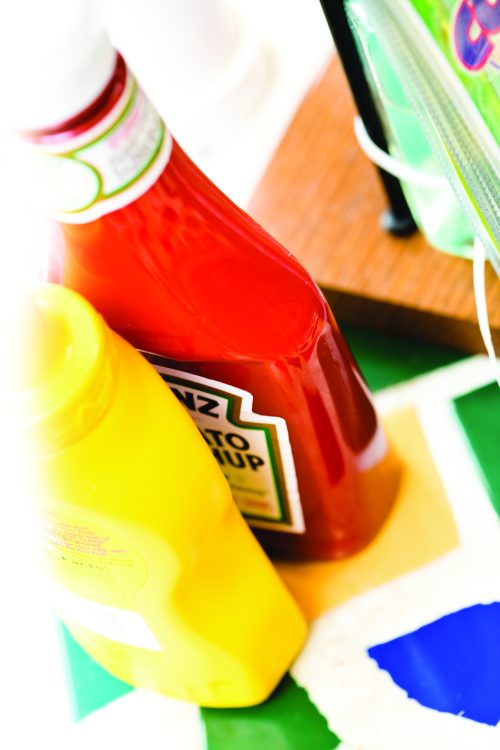
Condiments add lots of flavour, but what else do those dollops on the side and on top bring to a meal? Nutritionist Claire Turnbull investigates.
Mustard
What’s in it?
Mustards on the market include Hot, English, Wholegrain and Dijon varieties. The main ingredients are water, mustard seeds (mostly around 20-30 per cent), salt and sugar.
What it’s good for
Mustard is usually paired with hot and cold meats or used to add a punchy flavour to sandwiches. It is also a very useful addition to many dressings and sauces.
Nutrition information
Per two teaspoon serve, mustard has:
- around 60kJ with less than 1g fat
- a high sodium content – some have up to 200mg sodium
Our verdict
Mustard is a great condiment as it adds great flavour and a little goes a long way. If you are watching your sodium intake, keep to one to two teaspoons per serve and compare the sodium between different brands before you buy.
Look out for
Dijonnaise mustard. This is not the same as Dijon mustard. Dijonnaise mustard is a combination of mayonnaise and mustard, and it is much higher in fat and kilojoules than other mustards.
Tomato sauce
What’s in it?
Concentrated tomatoes, sugar, vinegar and salt.
What it’s good for
Some people add tomato sauce to everything! Others prefer to have it just with meat, burgers, fish and chips.
Nutrition information
Per tablespoon, regular tomato sauce varieties have:
- around 75-90kJ with less than 1g fat
- around 4g sugar (that is, one teaspoon)
- between 145-190mg sodium
There are ‘lite’ varieties available which are a healthier choice. Per tablespoon, ‘lite’ varieties have:
- 60-70kJ with less than 1g fat
- around 3g sugar
- between 25-80mg sodium
Our verdict
Tomato sauce is a low-fat sauce, which has the added bonus of lycopene, a powerful antioxidant. Regular varieties are, however, about one-third sugar (one teaspoon in every tablespoon) and also quite high in sodium. Best not to use too much sauce and definitely choose a light version where you can.
Tip
Use sliced tomato in burgers rather than relying solely on tomato sauce for a tomato flavour!
Fish sauce
What’s in it?
Water, anchovies and sugar.
What it’s good for
Fish sauce is a staple ingredient in Vietnamese and Thai cuisine. It is often added to dishes during cooking or mixed with other ingredients to create a dipping sauce.
Nutrition information
Per tablespoon, fish sauce is:
- low in kilojoules and sugar with less than 40kJ
- very high in sodium – can have up to 1500mg
Our verdict
A fantastic product which adds flavour, but as it’s often used with other high-sodium sauces, use sparingly.
Tip
Add water to your fish-sauce-based dipping sauce. Fish sauce is strong so you will still get the flavour with less sodium.
Worcestershire sauce
What’s in it?
Water, molasses, malt vinegar, spirit vinegar, sugar, salt, anchovies, onions, tamarind extract, garlic, spices and flavours.
What it’s good for
A popular ingredient in many marinades and a tasty addition to meat and chicken dishes.
Nutrition information
Per teaspoon, Worcestershire sauce has:
- 20kJ and 0g fat
- less than 1g sugar
- 60mg sodium
Our verdict
A great all-round condiment which can add flavour to lots of dishes. Low in kilojoules and fat, but as with so many condiments, try not to be too heavy-handed as it can significantly add to the sodium content of your dish.
Tip
For delicious chicken kebabs, marinade chunks of chicken breast or thigh in Worcestershire sauce and a splash of olive oil. Thread on kebab sticks and pop on the barbecue.
Chutney
What’s in it?
There are a lot of chutneys on the market which have some combination of vegetables/fruits, sugar, water, salt and flavours.
What it’s good for
Chutney adds flavour and interest to sandwiches, salads, burgers and barbecued meat.
Nutrition information
With such a variety in the type of chutneys, the nutrition information varies, too. There is a difference between what different manufacturers call a ‘serve’. Some call 10g a serve, others call 30g a serve. So for a more accurate comparison across different products, look at the per 100g column on the nutrition panel. Chutney variations, per two tablespoons, have:
- from around 100kJ to more than 300kJ
- 3g to more than 18g sugar
- from 50mg to more than 400mg sodium
One thing we found in this research is that the first ingredient in some chutneys is sugar or sugar syrup. Some chutneys also have less than one-third vegetables or fruit. Many of these are essentially the same as salty jam, so don’t kid yourself you are topping up on vegetables by adding heaps.
Our verdict
Choose chutney that has vegetables or fruit higher up the ingredients list than sugar. Choose a variety with less salt.
Tip
Make your own chutney so you know exactly what’s going into it.
Ranch dressing
What’s in it?
A thick, creamy dressing with herbs and black pepper.
What it’s good for
A popular salad dressing and dipping sauce.
Nutrition information
There is a huge variation in the nutritional value of ranch dressings. Of those we looked at, one tablespoon has:
- between 210-410kJ with between 30-65 per cent fat
- a high sodium content, with between 135-175mg sodium
Our verdict
Ranch dressing is a high-fat dressing for occasional use and best to use in small amounts if you are watching your waistline! Check the nutrition panel as lighter versions are available.
Wasabi
What’s in it?
Wasabi is also called ‘Japanese horseradish’ and horseradish is the predominant ingredient. The few other ingredients will vary, so check the label. Wasabi is available in powder and paste.
What it’s good for
Adds an intense heat to anything, most commonly seen alongside sushi and sashimi.
Nutrition information
Half a teaspoon of wasabi has around:
- 30kJ
- 50-60mg sodium
Our verdict
A fantastic condiment as it adds huge flavour in a tiny amount.
Tip
Mix one teaspoon of wasabi into a few tablespoons of light mayonnaise for a fabulous accompaniment to grilled salmon or tuna.
Soy sauce
What’s in it?
Water, soy beans, wheat (in most brands), salt and sugar.
What it’s good for
Soy sauce is a staple in Asian cuisine and is commonly enjoyed with sushi, in stir-fries, and to add flavour to sauces.
Nutrition information
One tablespoon of standard soy sauce has:
- 25-45kJ but more than 900mg sodium
There are lower sodium versions with similar kilojoules but around 500mg sodium.
Our verdict
Many people use soy sauce to flavour dishes on a daily basis but beware: you can get your total daily quota of sodium from just two tablespoons – and, let’s be honest – soy sauce is easy to use liberally. Measure it out with a teaspoon (one teaspoon has 300mg sodium – still a huge amount). It’s best to always go for the low sodium variety.
Tip
Measure soy sauce with a teaspoon, and use small amounts while cooking rather than pouring on at the table.
Sweet chilli sauce
What’s in it?
Sugar, water, chilli, garlic, vinegar and salt.
What it’s good for
A delicious dipping sauce commonly used in many Asian dishes, stir-fries and dressings.
Nutrition information
One tablespoon of sweet chilli sauce has roughly:
- 190kJ and less than 0.1g fat
- 10g sugar
- 250mg sodium
This makes sweet chilli sauce two-thirds sugar!
Our verdict
A versatile condiment with lots of flavour but watch out for sugar and sodium. Just dip or add a smidge rather than drown food in it.
Vinaigrette
What’s in it?
Oil, vinegar, herbs, spices. While a traditional vinaigrette is a 3:1 mix of oil and vinegar, there is a huge variety available in stores. Lower-fat versions are mostly vinegar based. It pays to read the label to know exactly what ratio mix you are buying.
What it’s good for
A classic dressing for salad leaves. Flavour variations are endless.
Nutrition information
Nutrition values vary across the range of vinaigrettes. A vinaigrette such as Paul Newman’s Own Vinaigrette has, per tablespoon:
- around 215kJ
- 3.5g fat
- less than 1g sugar
- 153mg sodium
Lower-fat versions such as Pams Balsamic use slightly less oil and are lower in energy. One tablespoon has:
- around 138kJ
- 3.5g fat
- less than 1g sugar
- 81mg sodium
Light and oil-free varieties such as Eta Lite & Free Balsamic are much lower in kilojoules. One tablespoon has:
- around 45kJ
- less than 1g fat
- 1.4g sugar
- 69mg sodium
Our verdict
If weight isn’t an issue, use your preference. Vinaigrettes use healthy oils but they can be high in sodium so as with most things, less is more. If you are watching your weight, read the label and use less of the traditional 3:1 ratio variety or use a light version.
Tip
Make your own with 50:50 oil and vinegar. Or just use lemon or lime juice to flavour a salad. Next to no kilojoules!
Mayonnaise and aioli
What’s in it?
Brands of mayonnaise vary enormously. Aioli and the thick and creamy varieties are made from the traditional blend of oil, egg and vinegar. Others are less thick and creamy and generally have less oil and more vinegar and water.
What it’s good for
Mayonnaise is incredibly versatile, most commonly used in sandwiches, burgers and with salads.
Nutrition information
It pays to check! Traditional oil and egg-based mayonnaise is very high in fat and kilojoules with around 70-80 per cent fat. Two tablespoons of mayonnaise can have:
- around 800kJ
- over 20g of fat – about the same as a chocolate bar
If you are watching your weight, scrape these on or use a lower-fat variety.
Light and lower-fat
Is a light (also called lite) mayonnaise always the better choice? It depends on which mayonnaise you buy.
- Don’t assume light versions are always the lowest in fat. One light mayonnaise we found has 35 per cent fat, which is the same as Eta’s standard mayonnaise.
- Others, though, can be a good deal lighter so check the labels.
Our verdict
Use the right mayonnaise for the job. If you can’t tear yourself away from the creamy higher-fat versions, stick to a small serving. If you regularly enjoy a fair amount of dressing, or you are making a potato salad or similar requiring a lot of dressing, using a lower-fat variety is best.
Tip
If you just love a thick and creamy dressing for a coleslaw or potato salad, mix one or two tablespoons of a lower-fat light mayonnaise with plain low-fat yoghurt. It will be still thick and creamy but with much less fat.
Quick check
- Fat: In an average 8700kJ day, 45-80g total fat and no more than 23g saturated fat is recommended.
- Sodium: We are advised to have no more than 2300mg sodium each day: 920-1600mg each day is ideal.
www.healthyfood.com


